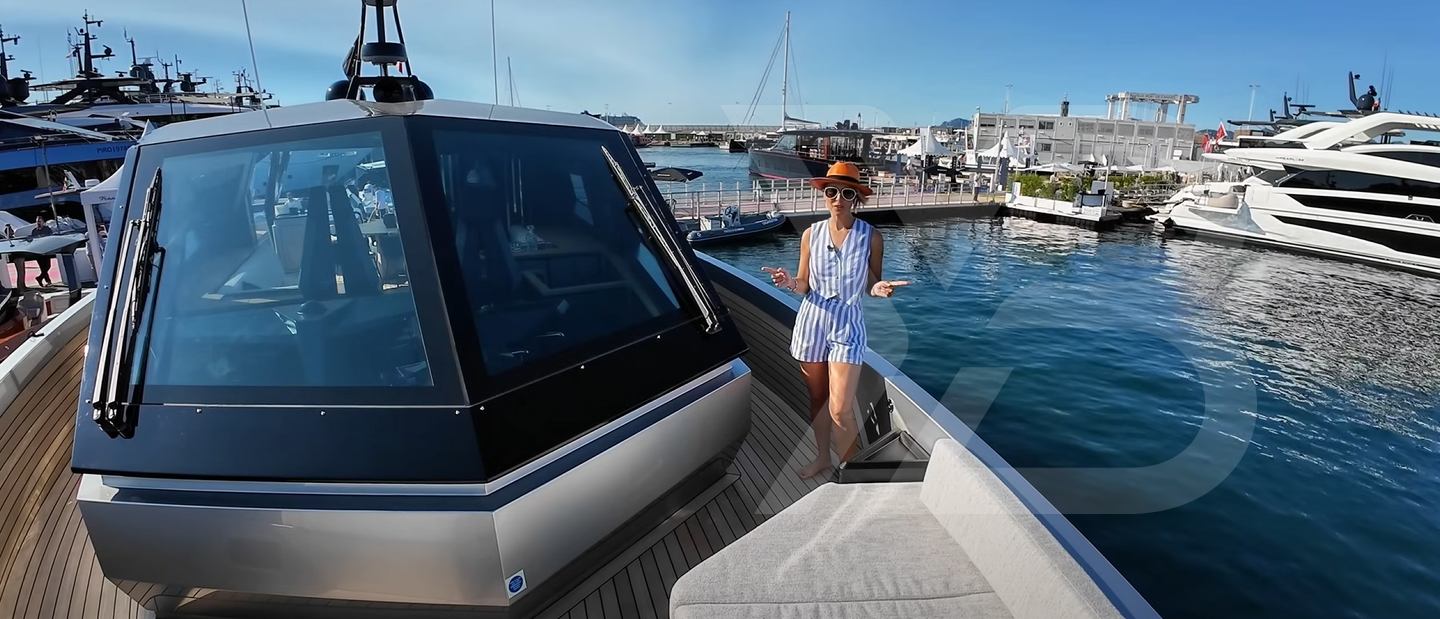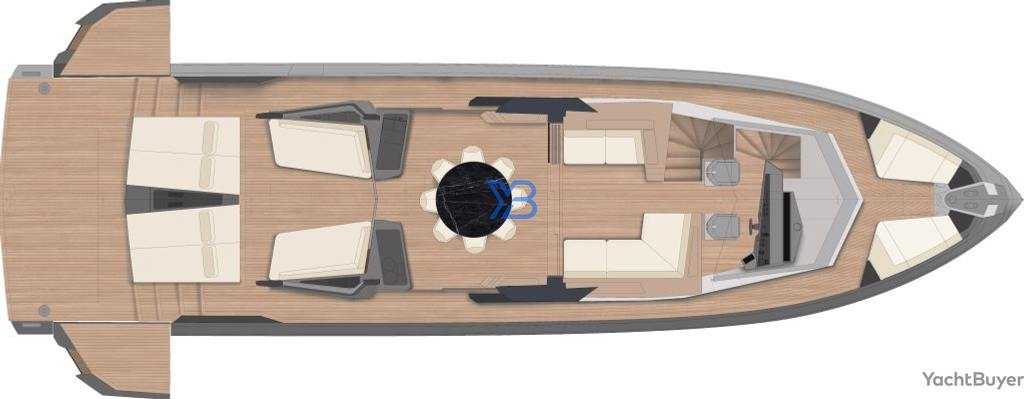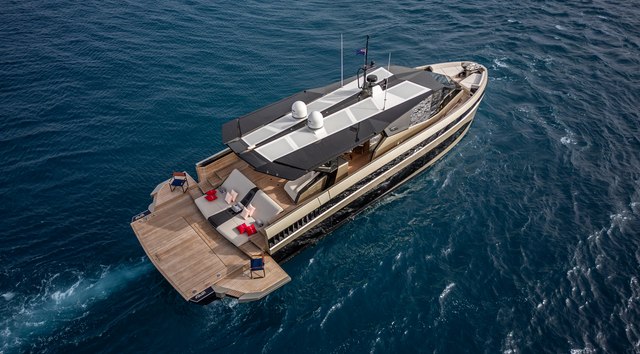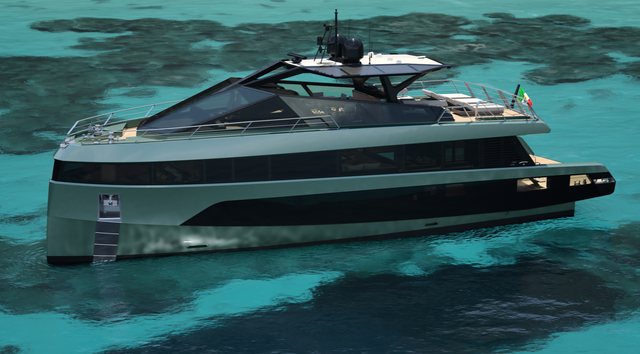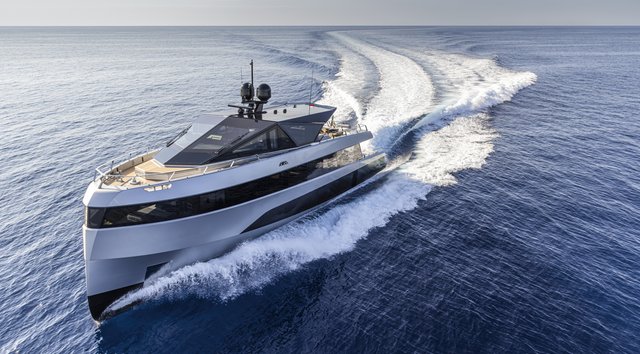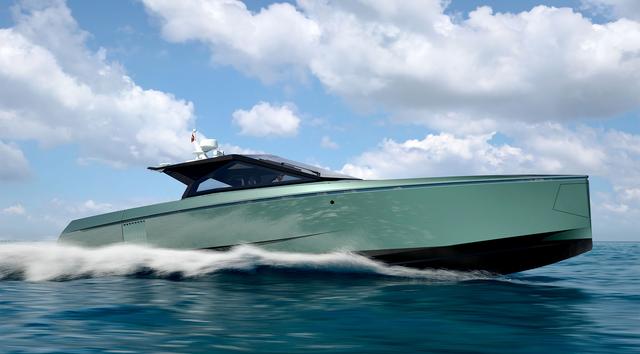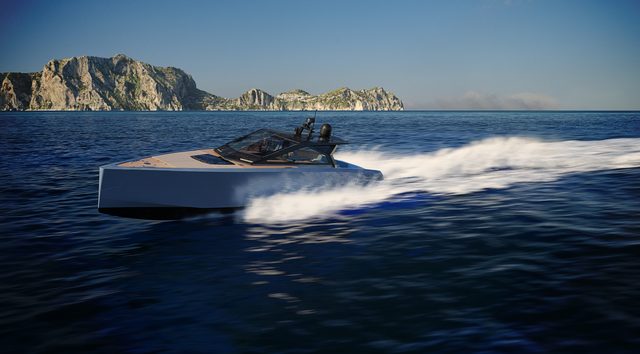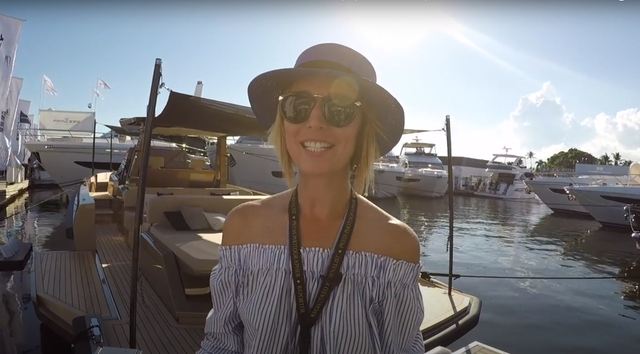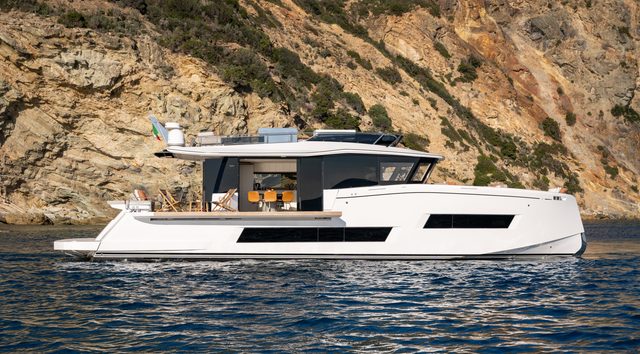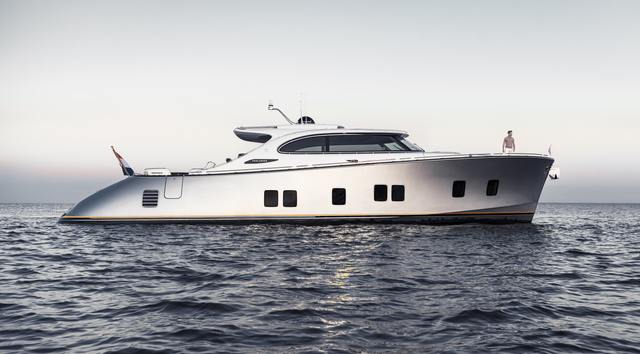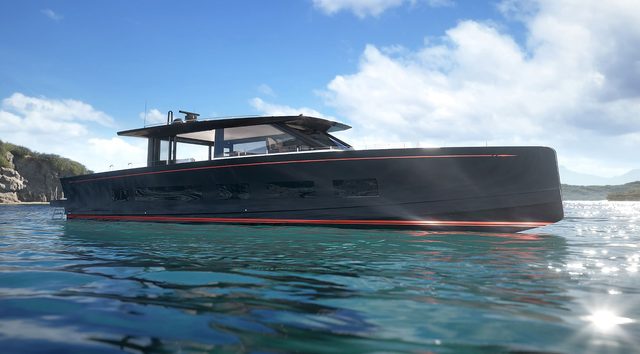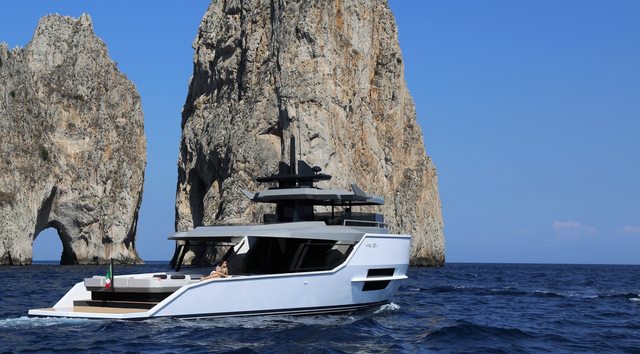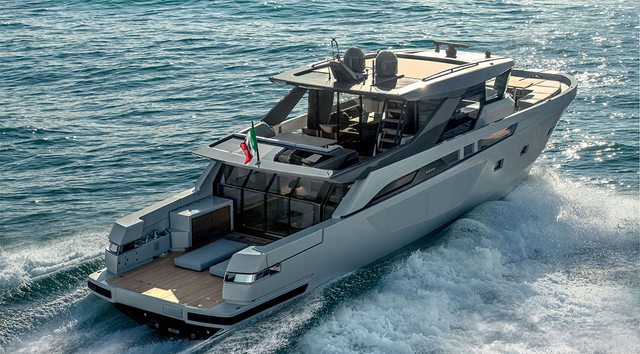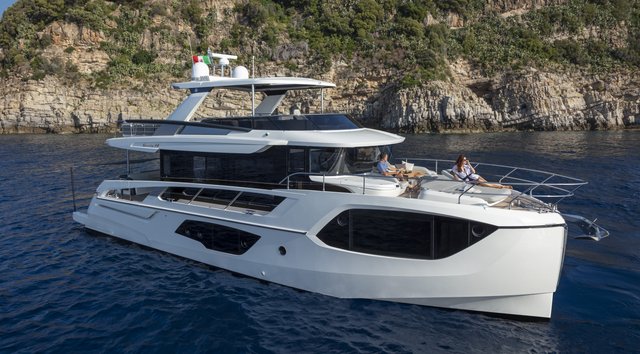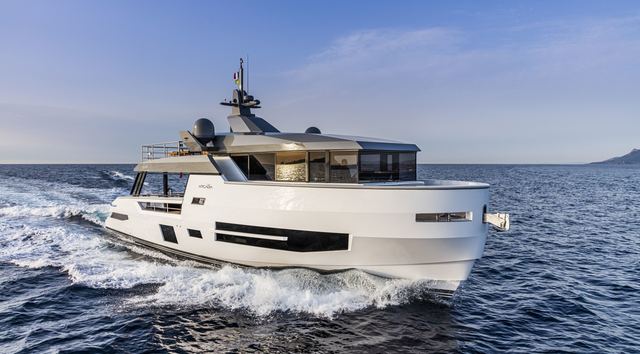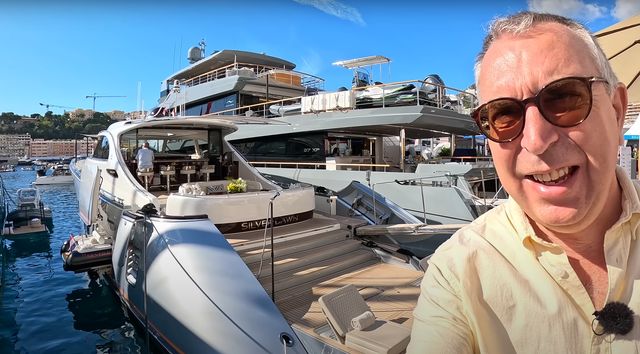This detailed walk-through explores Wally’s striking 68-foot, 100 GT yacht from its fold-out beach club and carbon fibre detailing to its high-tech interior, showing how this bold design blends dayboat freedom with true weekend comfort.
Video Tour
On Deck
The passerelle is impressively sturdy and stable, extending up for boarding and down into the water to double as a swim ladder. It makes embarking, disembarking, and swimming genuinely easy. The platform itself is hydraulic and can sink right below the surface, serving as both a swim deck and a tender lift. Owners can keep the tender here or stow it neatly in the garage just forward.
The aft deck feels huge for the boat’s length. In this version, the layout is all about lounging, with large sun pads, a built-in drink fridge, cup holders, and hidden speakers behind custom grills. Carbon fibre accents pop up everywhere, a nod to Wally’s sailboat heritage. Even the toilets are made of carbon fibre. The bulwarks fold out to expand the cockpit by about 30 percent, transforming it into a beach club right at the water’s edge. Beneath the sun pad is a deep storage compartment, and an alternative layout swaps this for a tender garage with the pad sitting on top.
There’s more deck storage along the way, including a drained locker that can double as an ice chest. The side decks lead forward past a shore power inlet and a sleek docking station with Volvo IPS joystick controls, thruster toggle, and fuel and waste shutoffs tucked neatly away. The teak decking runs all the way up the bulwarks, which gives the yacht that smooth, continuous look typical of Wally.
The hardware is cleverly hidden. Fender hooks snap into place with quick connects, and cleats are recessed inside the bulwarks to leave the deck completely clean. The bow area continues that minimalist style with twin sun pads, lockers beneath, cup holders trimmed in carbon fibre, and shade sockets for poles. It’s the kind of spot designed for relaxing in warm anchorages.
At the very front, twin windlasses sit inside a polished stainless steel tray, along with a mooring winch and hidden bollards. Lines feed cleanly through stainless-protected fairleads to avoid scuffing the paint. Twin anchor lockers hold the gear and a freshwater washdown hose. One of the forward hatches doubles as the emergency escape from the crew cabin below.
Up on the roofline, the radar, searchlight, and horn sit neatly on a carbon fibre mast. The overall look is sharp, futuristic and sleek from every angle.
Interior Accommodation
The aft lounge merges into an enclosed dining area through sliding glass doors. When closed, the space can be air-conditioned, but it still feels bright thanks to the skylights above. It’s the ideal hybrid space, working as both a formal dining area and an open-air terrace depending on the weather.
The wet-bar module is finished in carbon fiber, including the countertops and sink. It houses an ice maker, drink fridge, and discreet storage. Lighting is tucked into the joinery, creating a soft glow that suits the yacht’s futuristic lines. With the glass doors open, the transition from exterior to interior is almost invisible, keeping that breezy, open feeling throughout the main deck.
The salon itself carries Wally’s minimalist signature style, sculpted, and full of texture. There’s a settee for four or five guests with drawers built into the base, so nothing feels wasted. The curves, lighting, and carbon accents create an unmistakably modern mood.
The helm takes the spaceship theme even further. The dashboard, wheel, and helm chairs are all carbon fibre, and the shapes are geometric and bold. Triple chartplotters dominate the console, with one screen for system management and another streaming live footage from the engine room. Controls for the Volvo IPS joystick, throttles, bow thruster, autopilot, searchlight, and lights are neatly grouped. A side door by the helm makes line handling straightforward during docking.
This model features two Seakeepers (a 9 and a 6) instead of one large unit. It’s a clever setup that lets the operator run only the smaller gyro in calm conditions or both when it gets rough. It saves energy and offers flexibility depending on the sea state. The recycled Alcantara-style wall finishes and curved ceiling transitions tie it all together, softening the technical look.
Owner's Cabin
The full-beam owner’s suite aft feels open and inviting, with huge hull windows that flood the space with light. A long curved settee stretches along one side, almost large enough for a child’s berth, and drawers line the base of the king-size bed. The lighting is subtle and indirect, emphasizing the gentle ceiling curves that flow into the side panels. A TV and hanging locker are built in, and a small drink fridge sits beneath additional storage cabinetry.
The ensuite continues the carbon fibre theme. The privacy glass door turns opaque at the touch of a button. Inside, the toilet, sink, and shower are all finished in more carbon fiber with fixtures to match. Deep folding cabinets offer more space than their slim design suggests.
Guest Accommodation
The guest area starts with a day head that doubles as an ensuite for the starboard twin cabin. The shower has a teak bench, an overhead rain head, soft lighting, and a polished sink. There’s even a bidet option and a small porthole for ventilation.
The starboard cabin itself offers two single beds that slide together to create a double. The door to the ensuite is hidden behind a full-length mirror, keeping the space looking clean. Reading lights are magnetic so you can lift them from the wall and they switch on automatically. There’s a TV, a hanging locker, and drawers beneath the berths.
Across the hall, the port-side cabin features a queen bed and a long hull window that curves up toward the ceiling. The closets are flush and disguised behind paneling, making them easy to miss at first glance. Once opened, they reveal generous hanging space and drawers. A wave-shaped nightstand and lots of subtle indirect lighting add warmth to the otherwise sharp design.
Crew Accommodation
Forward of the galley sits the crew cabin. It’s compact, fitted with bunk berths, a hanging locker, and a private ensuite. The bathroom uses a wet-head layout where the toilet and shower share the same space but are neatly separated by design. The laundry setup includes a Miele washer-dryer combo, tucked out of the way but close at hand. The escape hatch above leads directly up to the foredeck.
Performance
The breaker panels (24-volt and high-voltage) sit right outside the engine room, both clearly labeled. Inside, large DC inverters occupy the port side along with the hydraulic pack for the passerelle. The twin Volvo Penta D13 IPS1200 engines produce 900 horsepower each, with the option to upgrade to D13 IPS1350s for 1,000 horsepower per side.
Service points such as fuel filters, chargers, and battery boxes are easily reached. The sight glass for the fuel tank is right in front of the walkway, and the fire suppression system is positioned for quick access. The generator sits neatly to starboard.
Performance numbers are strong for this size and volume: a top speed of around 25 knots with the standard setup, or 27 knots with the upgraded engines. Cruising at 22 knots (24 with the larger engines) delivers a range of about 360 nautical miles. Fuel capacity stands at 1,215 US gallons, or roughly 4,600 liters.
Ownership Considerations
Wally is part of the Ferretti Group family, so warranty and service support are covered by their global network. Owners can count on established Ferretti and Volvo service centers around the world for scheduled maintenance, warranty work, and parts. Routine service for the Volvo IPS drives and Seakeeper gyros can be done at any authorized Volvo or Ferretti yard, which makes life easier if the yacht cruises beyond its home base.
This model follows Wally’s gross tonnage naming system following the same logic as the larger why150 and why200. The “100” reflects its 100 GT volume rather than its length, which is just under 68ft. That volume translates to real interior comfort, and for an owner-operator it’s a very manageable size. The helm side door helps during docking, especially when handling lines solo, and the IPS joystick gives fingertip control in tight slips or crosswinds.
Materials are high-end but practical. Teak needs gentle cleaning and annual oiling to keep its tone, and carbon fibre surfaces should get a UV-safe polish now and then to stay glossy. Both Seakeepers follow the standard 1,000-hour service cycle and can be handled by the same technician who maintains the engines.
Rivals worth considering when looking at a wallywhy100 would be the Pardo E72 and the Bluegame BGX73.
In Summary
The Wallywhy100 takes Wally’s unmistakable spaceship look and turns it into a practical, owner-friendly yacht.
Looking to own a Wally wallywhy100? Use YachtBuyer’s Market Watch to compare all new and used Wally wallywhy100 Boats for sale worldwide. You can also order a new Wally wallywhy100, customized to your exact specifications, with options for engine choice and layout configuration. Alternatively, explore our global listings of new and used boats for sale and find your perfect boat today!
Specifications
- Builder Wally
- Range WHY
- Model wallywhy100
- Length Overall 21.46m
- Beam 5.73m
- Draft 1.7m
- Hull GRP
- Cabins 3
- Berths 4
- Crew 2
- Cruising Speed
- Max Speed
- Fuel Capacity 4,600 Litres
- Fresh Water Capacity 900 Litres
- Engine Model 2x Volvo Penta D13-IPS1200
- Engine max range (speed type) 420 (nm)
Interested in a wallywhy100?
NEW Build
Find your local dealer for a personalised, no-cost consultation
or just request
Brochures & Pricing
Used & In Stock
Looking for a ready-to-go wallywhy100 or pre-owned options? Explore all inventory of the wallywhy100 available worldwide
